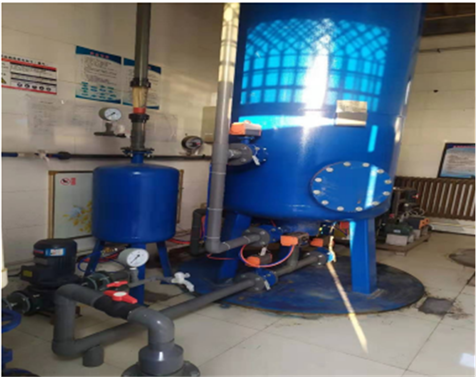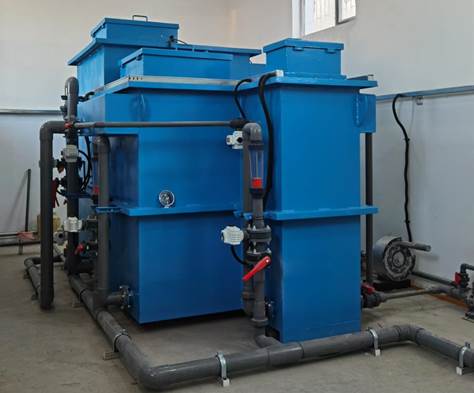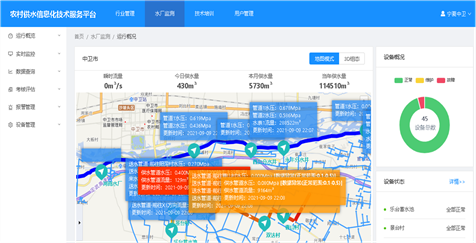Main Participants: LI Bin, LYU Yufeng, LI Xiaoqin, ZHANG Yanhua, YANG Jifu, SHEN Yehui, MENG Zhaoyu, GUO Chao, SUN Fang, YIN Shuang
Drinking water safety is a matter of the tangible benefit of hundreds of millions of people, and the Chinese government put a premium on drinking water safety in rural areas. Although the drinking water problems have all been generally solved in China's rural areas, the water supply security remains a tough challenge for the countryside due to poor source water quality, outdated technology, inefficient management, unreasonable layout of water supply projects to name a few. Especially in some typical areas in Northwest China, problems such as excessive amounts of iron and manganese, and excessive nitrite are quite prominent, while there are lack of effective treatment technologies; water supply network aging and leakage has led to serious secondary pollution. In the meantime, many of the water supply projects are small and decentralized without professional operation or appropriate management, which leads to the inefficiency of water supply. Irrational allocation of water resources has led to a low level of ensured water supply and further exacerbated the water supply security problem. Therefore, the research on technologies for improving rural water supply security is of great practical importance.
· Having developed the biological iron and manganese removal process and equipment tailored to rural areas in Northwest China, which has made water distribution more even through compartmentalization and compressed air-water backwashing technologies, increased the backwashing flow rate per unit area by a factor of 1, and effectively improved the iron and manganese removal efficiency and backwashing effect, showing significant water and energy conservation benefit.
· Having developed a low-carbon and environmental friendly biological treatment technology and equipment suitable for treating groundwater with excessive nitrate, realized green and fully automatic operation at low temperatures, with water quality better ensured in rural areas.
· Having developed air-water pulse equipment suitable for small-diameter and low-pressure rural water supply networks to solve the common problems in rural water supply networks, such as secondary pollution, and discharge of muddy or black water at the end of the networks.
· Having developed a drinking water safety information management system integrating data acquisition, storage, statistics and analysis for villages and towns in Shapotou District, and established a rural water supply network leakage monitoring model through the GBDT algorithm-based XGBOOST method, with fine management of rural water supply improved.
· Having worked out a plan for urban and rural water supply projects in Hebei and a plan for consolidating and improving rural drinking water safety in Henan through integer programming model calculation for rural drinking water sources and water balance analysis, maximized the intensification and professional management of rural water supply projects..
· Having realized more even water distribution and more efficient backwashing in the biological iron and manganese removal device through intra-pipe compartmentalization and compressed air-water backwashing technologies, with energy saved and efficiency improved.
· Having developed a highly active de-nitrification microbial suitable for low temperatures by selecting composite fillers with high bio-adhesion and high volume load capacity and easily-absorbed and low-cost carbon sources, optimized the parameters of the process for biological treatment of groundwater with excessive nitrate, and created integrated water treatment equipment with a compact structure.
· Having developed a pack of air-water pulse treatment technology and equipment to address the secondary pollution in small-diameter and low-pressure rural water supply networks, effectively solving the problem of secondary pollution.
· Having realized data security and connectivity, business process simplification and network leakage monitoring and early warning by developing an XGboost network leakage monitoring model suitable for water plants with small-scale data, improving water supply management and water conservation in rural areas.
· Having developed a layout and plan for optimizing rural water supply security across the district based on the needs of future urbanization and urban and rural water supply integration, solving the problems with water supply projects in Shapotou District, such as small scale, decentralized distribution, insufficient support for water supply and low sustainability.
· A demonstration project of the whole pack of technology and equipment for treatment of water with excessive iron and manganese has been built at Jiutang Water Supply Station in Zhenluo Town, Shapotou District, with a water supply capacity of 120m3/d, benefiting 1,200 people. The technology and equipment for treatment of water with excessive nitrate have been applied to 17 rural water supply projects in Fuxin Mongol Autonomous County, Benxi Manchu Autonomous County and Huanren Manchu Autonomous County in Liaoning Province, benefiting 39,600 people. The treated water of these projects all meets the requirements of the Standards for Drinking Water Quality (GB5749).
· The air-water pulse technology and equipment for water supply networks have been applied to the water pipelines in Zhenluo Town. The demonstration project covers 8.5km of PVC pipes, with their diameters ranging from 75 to 125mm, averagely increasing the flow area by 29.3%, basically restoring to the delivery capacity of waterworks outlet pipes, lowering the annual washing costs per kilometer of pipes by 90.0% and saving water by 99.2%.
· The rural drinking water safety information management and automatic monitoring system has been established for Xuanhe Water Supply Station in Xuanhe Town, Shapotou District, benefiting more than 25,000 people and reducing the water supply pipeline network leakage rate by 10%.
· The research has led to a plan for connecting water supply projects and improving water sources in three towns south of the Yellow River and a renovation plan for urban and rural water supply integration in four towns north of the Yellow River, both plans have been demonstrated in pilot projects, covering more than 300,000 people.

Fig.1 Biological iron and manganese removal equipment

Fig.2 Complete device for treatment of water with excessive nitrate

Fig.3 Schematic diagram of the air-water pulse equipment for water supply networks

Fig.4 The waterworks monitoring interface of the rural water supply information technology service platform